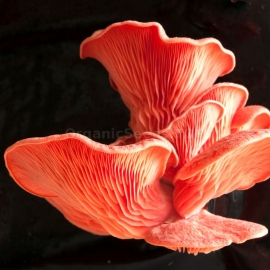 EXCLUSIVE
EXCLUSIVE
«Black Truffle» (Tuber melanosporum) - Organic Mushroom's Dry Mycelium
6.10 €
A genus of marsupials with underground tuberous fleshy fruiting bodies, considered valuable delicacies, in the form of irregular tubers, usually 2-12 cm in size and weighing 30-300 grams, the surface is uneven, covered with a thin velvety skin.
-
Mycelium of the mushroom «Black Truffle» / Tuber melanosporum
A genus of marsupials with underground tuberous fleshy fruiting bodies, considered valuable delicacies, in the form of irregular tubers, usually 2-12 cm in size and weighing 30-300 grams, the surface is uneven, covered with a thin velvety skin.
Many mysteries surround these mushrooms. No one in nature has ever seen them grow - not even those who have been collecting them for years. After all, the whole life of a truffle takes place underground and is completely dependent on trees or shrubs, the roots of which become their breadwinners, sharing carbohydrate reserves. The most valuable among all truffles are white Italian truffle and black French truffle.
It turns out that under certain conditions, truffles can be grown even in a greenhouse in the country. What will be needed for this? First of all, prepare the necessary seed material - mushroom mycelium and nutritional components for planting: earth taken from the upper soil layer in a deciduous forest along with tree leaves; nutrient solution containing NPK fertilizers (nitrogen-phosphorus-potassium); freshly cut wood of those tree species, in symbiosis with which the truffle grows in the form of sawdust or shavings.
Oak is considered the best tree for this. Beech, hornbeam, hazel, walnut are also suitable. It is unacceptable to use such species as poplar, willow, chestnut, spruce, pine.
Growing mushrooms in a greenhouse in stages is as follows: prepare the soil in the greenhouse by sifting it before backfilling in order to saturate it with oxygen and remove stones, carefully controlling its acidity, which should not exceed 7.5 units; pour a layer of sawdust or shavings on the beds with prepared soil; mix mycelium with a small amount of land treated with NPK fertilizers; pour the resulting mixture onto a layer of sawdust or shavings;
Now you can “forget” about truffles for a couple of months, occasionally watering plantings moderately (these mushrooms do not like high humidity) and weeding out weeds, which truffles also really dislike. After two months, you can try to harvest the first crop, but you should not immediately hope for stunning results - it takes at least a year for the mycelium to take root completely. The main peak of yield is observed after 2-3 years from the moment of planting, the number of mushrooms will increase every year.
Truffles are dug up after discovery in much the same way as potatoes, only with more care so as not to damage the mycelium. Amateur cultivation of mushrooms does not give a guaranteed result, since the growth of mushrooms is highly dependent on many factors.
A very important factor for the successful cultivation of mushrooms is the acidity of the soil. For truffles, the optimal value of acidity is Ph = 7 -7.5. More acidic soil (the Ph number is less) must be deoxidized by watering with a solution of quicklime (100 g of lime per 5 liters of water per 1 sq.m.) We recommend
using the MYCELIUM ACTIVATOR when planting, which contains a set of NPK fertilizers necessary for the development of mycelium, a hydrogel to retain moisture , soil deoxidizer, as well as tests-indicators for monitoring soil pH levels.
With this product buy
6.10 €
Traditional and contemporary Chinese medicine admire it as a tonic benefiting vital energy or "Qi", and it is popularly prescribed for a multitude of maladies. Reishi is a polypore mushroom, growing in damp, dark forests and the occasional rotting log.
6.10 €
Pink Oyster mushrooms are truly spectacular in their vibrant pink color. Our pink oyster strain is the pleurotus djamor var. roseus and is the most vibrant strain with pink gills. The vibrant pink varies by age and light conditions.
6.10 €
The saffron milkcap is one of the only edible milkcap mushrooms. It grows in the summer and autumn months under the canopy of pine trees and is distinguished by its convex cap with rolled lip, particularly noticeable in young specimens.
6.10 €
Fruit bodies of Agaricus bernardii have caps that range in shape from convex to flattened, and reach a diameter of 5–15 cm (2.0–5.9 in). The cap surface is dry and smooth, with a white or buff color that can develop brownish spots in maturity.
Products Viewed Before
Product code: 11634
1.14 €
2.78 € (Sale: 58%)
Highly productive large-fruited variety with high adaptation to stress and disease! Mid-early, consistently productive Siberian giant for protected ground. Forms abundant clusters of raspberry, flat-round fruits weighing up to 600 grams.
Product code: 11640
1.14 €
2.78 € (Sale: 58%)
Very early, indoor, high-yield and unpretentious cultivar of author's selection from the USA. The bush is about 30 cm high. When grown in the open field, with the onset of autumn, it is very easy to transplant it into a large pot and bring it into the hou






